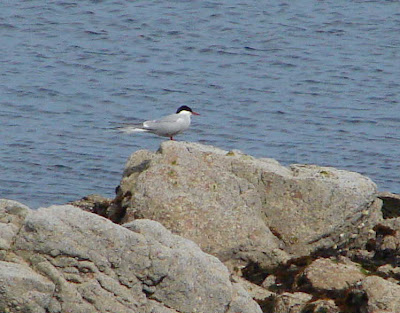Yet another calm morning with the sun gradually dispelling the clouds. The forecast for the day was not too good but as it turned out we had another brilliant day apart from a couple of extremely brief showers around 10.30 pm.


In the afternoon I had a wander around the garden and on the croft seeking insects. On GB's Cotoneaster a Drone Fly, the harmless hoverfly Eristalis tenax, was busy collecting nectar. There is an easy way to distinguish hoverflies from bees and wasps; hoverflies have a vein that runs the length of the wing. Unfortunately it's not much help to those who are afraid of bees and wasps because the chances of them getting close enough to see the vein are pretty remote!


Another insect on the Cotoneaster was a Bluebottle. There are a number of similar species but one of the most common is Calliphora vomitoria whose scientific name is about as attractive its habits!

There were plenty of buttercups in flower on the croft and another fly species was happily feeding in virtually every flower. Not sure what the fly was. A small orange species of Sawfly from the family Tenthredinidae) was also about as were lots of Green-veined Whites.



In the late afternoon I had a walk down the croft and onto the beach. A Meadow Pipit was one the fence and I found a few Heath Spotted Orchids out.


Iain and Zena's house from the beach, against the sun. GB's house is just over the horizon to the right of Iain's.

The remains of a sea urchin.

I think this is some sort of bryozoan. It was just washed up on the sand.

The tide was out, revealing some of the wracks. These are Bladderwrack, also known as Popweed (Fucus vesiulosus), and Tangle or Oarweed (Laminaria digitata).



This is Serrated Wrack (Fucus serratus) but I don't know what the white things on it are.

As always I could not resist photographing Bayble Island. Although it goes by the name Bayble Island it is in fact two separate islands with a iny channel in between but the angle from which we see them in Bayble Bay makes them appear as one.

None of the rocks that sit under the water at high tide cane be seen beneath the layers of seaweed or barnacles and limpets.


Because the shore is generally so rocky they are few shells to be found on it as a rule but the calmer seas of the last couple of tides have resulted in a couple of shells surviving the pounding, including some large Pod Razors (Ensis siliqua).


A delightful rock pool as the tide reaches its lowest point of the afternoon.


Two Common Terns seem to inhabit the little beach on a regular basis - perhaps they nest nearby. Today one of them kept dive-bombing the other but I couldn't work out whether it was a display of affection or aggression.



There is lots of Yellow Flag Iris alongside the stream on the croft and the first of this year's blooms came out today.

No comments:
Post a Comment
Welcome - comments are nearly always appreciated (the exception being those that simply advertise which don't make it past my moderation so please, don't bother).